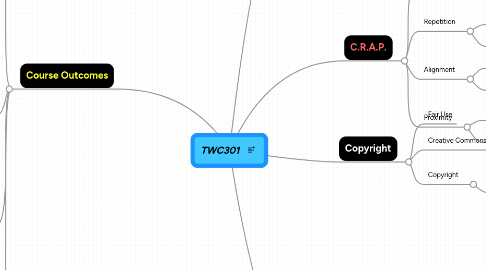
1. Course Outcomes
1.1. Rhetorical Knowledge
1.1.1. Identify, articulate, and focus on a defined purpose
1.1.2. Respond to the need of the approariate audience
1.1.3. Respond appropriately to different rhetorical situations
1.1.4. Use conventions of format and structure appropriate to the rhetorical situation
1.1.5. Adopt appropriate voice, tone, and level of formality
1.1.6. Understand how each genre helps to shape writing and how readers respond to it
1.1.7. Write in multiple genres
1.1.8. Understand the role of variety of technologies/media in accessing, retrieving, managing, and communicating information
1.1.9. Use appropriate technologies to organize, present, and communicate information to address of audiences, purposes, and genres
1.2. Critical Thinking, Reading, and Writing
1.2.1. Use information, writing, and reading for inquiry, learning, thinking, and communicating
1.2.2. Integrate previously held beliefs, assumptions, and knowledge with new information and the ideas of others to accomplish a specific purpose within a context
1.3. Processes
1.3.1. Be aware that it usually takes multiple drafts to create and complete a successful text
1.3.2. Develop flexible strategies for generating, revising, editing, and proof-reading
1.3.3. Understand the collaborative and social aspects of research and writing processes
1.3.4. Use appropriate technologies to manage data and information collected or generated for future use
1.4. Knowledge of Conventions
1.4.1. Learn common formats for different genres
1.4.2. Develop knowledge of genre conventions ranging from structure and paragraphing to tone and mechanics
1.4.3. Understand and apply legal and ethical uses of information and technology including copyright and intellectual property
2. Academic Goals
2.1. Apply the tools used in this course to develop a social interaction between users
2.2. Understand better the formats of blogs and other web-based media used for social interaction
2.3. Discover more tools to increase my writing skills and potential
2.4. Increase my academic vocabulary
3. Virtual Culture Notes
3.1. Virtual Communities
3.1.1. Revolutionized social interactions online
3.1.1.1. Electronic Frontiers Foundation
3.1.1.2. Emerged during '80s
3.1.2. Democratic participation
3.1.3. Social Psychology of VC
3.1.3.1. Discussion Groups
3.1.3.1.1. Form friendships
3.1.3.2. Chat Rooms
3.1.4. Digital divide
3.1.4.1. 18 largest internet usage nations make up 81% of world usage
3.2. Virtual theory
3.2.1. Vastly changed from the '90s to '00s
4. C.R.A.P.
4.1. Contrast
4.1.1. Bold, italics, color
4.1.2. Separation for unlike elements
4.2. Repetition
4.2.1. Repeating same bold, color, hyperlinks, etc.
4.2.2. Repeating aspects of design
4.3. Alignment
4.3.1. Keeping text to same side of page
4.3.2. Justify to emphasize key points
4.4. Proximity
4.4.1. Separating different types of content
4.4.2. Limit and separate key elements
5. Copyright
5.1. Fair Use
5.2. Creative Commons
5.2.1. Adds multimedia that can be used by others online
5.3. Copyright
5.3.1. Always copyright, any byte changed could possibly be copyrighted by someone else
